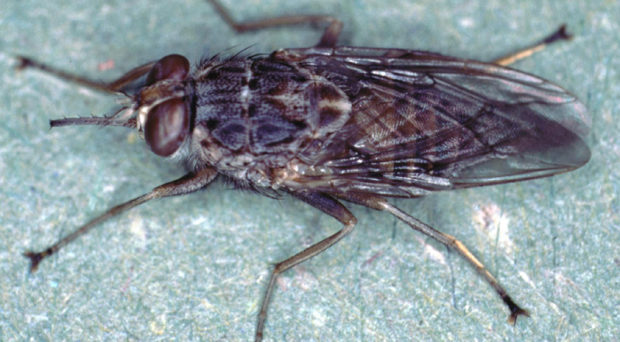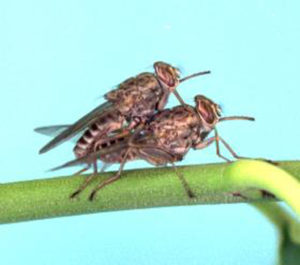
Tsetse flies are responsible for the spread of African sleeping sickness and the animal disease nagana. They are large, long-lived flies, both males and females inflicting a painful bite when they take a blood meal. All tsetse flies belong to the genus Glossina and are found in large parts of tropical Africa.
Tsetse flies produce a single embryo approximately every 10 days. The embryo develops in utero, where it passes through larval stages, being fed a milky substance produced by a modified gland. It is deposited as a final stage instar, and pupates in the soil. Eliminating a few tsetse flies can cause a rapid decline in the population, making the use of baited traps a successful control measure.
Tsetse traps are made of insecticide-impregnated screens of blue and black material that move in the wind. Much attention has been paid to the response by various tsetse species to odorants such as “odor of ox”, that can act as bait in these traps.
Odorants are volatile chemicals produced by plants or animals, that can be sensed by an animal’s odor receptors. They can elicit specific behaviour patterns such as attraction to food sources.
Pheromones are also volatile chemicals sensed by odor receptors and initiating particular behaviours, but produced by members of the same species. Insect pheromones can act as attractants, arrestants (keeping the responder in the vicinity) or aphrodisiacs.
Relatively little is known about tsetse pheromones. One aphrodisiac has been identified, but it only operates at a very short range and would not be suitable for a trap bait.
A recent paper published in Science has shed more light on pheromones involved in tsetse mating behaviour.
Pheromone extraction and testing
Initial observations, made by the team based at Yale University, noted that male Glossina morsitans rapidly mount virgin females when a pair are placed together in a tube, and contact lasts several minutes. They show little interest in already mated females.
Potential pheromone extracts were obtained from virgin and mated females and males by soaking them in hexane for 24 h, and the extracts applied to a decoy made of a knot in a rope. Male tsetse flies interacted with the decoy for more than 5 mins when virgin female extract (60%) was applied, and less so to mated female extract (27%). They did not interact if male extract was applied.
Pheromone identification
Gas chromatography-mass spectrometry (GC-MS) analysis of the extracts identified six compounds known to be pheromones in other insects: three fatty acids and 3 fatty acid methyl esters. Interestingly, a methyl branched alkane was abundant in males, and also in mated females, but not in virgin females. The authors suggested this may act as a deterrent that is transferred to females during mating, explaining why males do not display mating behaviour towards other males and rarely to already mated females.
Of the six insect pheromones, the researchers focussed on methyl palmitoleate (MPO) which elicited male mating behaviour in 87% of the decoy tests.
Behavioural assays

Male tsetse flies stayed on the MPO baited decoy for several minutes, suggesting MPO could be acting as an arrestant. However, when female tsetse flies of a different species, G. fuscipes, were coated with MPO dissolved in hexane, and introduced to male G. morsitans, the males mounted and attempted to copulate with these females. This did not occur when G. fuscipes were coated with hexane alone, so MPO also may be an aphrodisiac. Finally, when the males were given a choice between two arms of a T maze, one with MPO and one a control, the MPO arm elicited a response as an attractant.
Thus, MPO could be acting an arrestant, an attractant and an aphrodisiac.
Odor receptors
If these tests were performed with males that had had their antennae removed, there was no response, supporting the view that MPO elicited an olfactory response.
Single-sensillum electrophysiology was used to detect responses of sensilla on the lateral face of the antennae of G. morsitans, to hexane alone, or the three methyl esters. The researchers narrowed down their focus to specific classes of sensilla that have two odor receptor neurones (A and B). The B class of neurones reacted to MPO in a dose responsive manner, with greater magnitude of response being observed in males than in virgin females. A further subset of these receptors also responded to other known tsetse attractant odors.
The effect of trypanosome infection
The researchers next asked whether infection with Trypanosoma brucei brucei (a parasite that causes sleeping sickness in humans and nagana in animals) changes tsetse fly response to these odorants, or the behavioural response they elicit. Hexane extracts from mated males and females that were infected contained 21 odorants not detected in uninfected flies or virgin males or females. These included α-pinen, a volatile produced by the malaria parasite, which raised the question of whether these volatiles are produced by trypanosomes, or are a host response to infection.
A comparison of infected and uninfected male tsetse showed that infection had no effect on male mating behaviour. However, if presented with a choice of infected or uninfected females, males always mated with uninfected ones. Males would have a distinct advantage if they could detect whether females were infected, and thereby avoid mating with them, as, in common with many infected insects, trypanosome infection reduces the fecundity of female tsetse flies.
Methyl palmitoleate
These findings suggest MPO could act initially as an attractant to bring males to virgin females, then as an aphrodisiac and finally as an arrestant to maintain contact for the longish period required to complete copulation.
In the wild, tsetse fly mating occurs on or near a host. It is possible that host odors that act as attractants may also enhance the circuits that initiate sexual activity and raises the possibility that traps baited with both a host odorant, and an aphrodisiac pheromone could be more successful than the present ones.

Comments